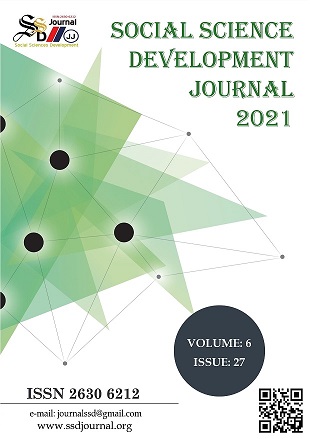İLETİŞİM SANAT EĞİTİMİ: BİR SÖYLEŞ ANALİZİ TÜRK DRAM OKULLARI ONLINE İLETİŞİM
DOI:
https://doi.org/10.31567/ssd.497Anahtar Kelimeler:
Pazarlama, Konservatuvar, İletişim, Söylem AnaliziÖzet
Türk tiyatrosunun gelişimi, modernleşme tarihinden birçok iz taşımaktadır. 1830’lardaki Tanzimat
Dönemi’nden itibaren İmparatorluk, Batı tarzı dramatik yazarlık, oyunculuk ve sahnelemeyi
kültürel ve sosyal çevresiyle teşvik etmişse aynı motivasyon Cumhuriyet dönemimde daha da
büyük bir ivmeyle devam etmiştir. Ne var ki, akademi çatısı altında modern drama eğitimi veren
üniversite bölümlerinin kurulması, 1940’ları bulmuştur. Bu zamana kadar tiyatro sanatının
icracıları, sanatlarının hünerlerini kurumsallaşmış Batı modelindeki okullar yerine ağırlıklı olarak
usta-çırak ilişkileriyle aktarmıştır. Önce Ankara, devamındaysa İstanbul ve Eskişehir gibi illerde açılan konservatuvarlarla, drama
eğitimi farklı bir boyut kazanmıştır. 1990’larda vakıf üniversitelerinin açtığı bölümlerle görece ağır
ilerleyen süreç hareketlenmiş, 2021 yılına geldiğimizdeyse sadece İstanbul’da 13 vakıf ve 2 devlet
üniversitesinde bulunan tiyatro bölümleriyle yoğun bir rekabet ortamı şekillenmiştir. Bu ortamda
öğrenci adayları ve her türlü paydaşla kurulan iletişimin niteliği önem kazanmıştır. Güçlü yanları,
farklılaşma noktaları ve özgün taraflarını farklı mecralarda anlatma ihtiyacı artan okulların internet
sitelerinde kendilerini nasıl tanıttıkları da ayrıca dikkat çekmeye başlamıştır. Bu çalışmada,
İstanbul’daki tiyatro bölümlerinin internet sayfaları incelenmiştir. Dünya görüşlerini, eğitim
hedeflerini, değerlerini ve iletişim tarzlarını ortaya koymak amacıyla bir söylem analizi yapılmıştır.
Buna göre okulların ideal tiyatro insanı kurgulayarak çok boyutluluğu işlediği, retorik yapılarını
ağırlıklı olarak logos ve etos üzerine inşa ettiği ve zıt kavramlar üzerinden farklılaşma noktalarını
vurguladıkları sonucuna ulaşılmıştır




